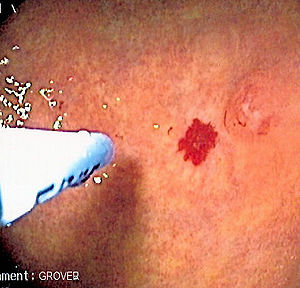Angiodysplasia
| Angiodysplasia | |
|---|---|
 |
|
| Endoscopic image of argon plasma coagulation of colonic angiodysplasia. | |
| Classification and external resources |
In medicine (gastroenterology), angiodysplasia is a small vascular malformation of the gut. It is a common cause of otherwise unexplained gastrointestinal bleeding and anemia. Lesions are often multiple, and frequently involve the cecum or ascending colon, although they can occur at other places. Treatment may be with colonoscopic interventions, angiography and embolization, medication, or occasionally surgery.
Although some cases present with black, tarry stool (melena), the blood loss can be subtle, with the anemia symptoms predominating. Fecal occult blood testing is positive when bleeding is active. If bleeding is intermittent the test may be negative at times.
Diagnosis of angiodysplasia is often accomplished with endoscopy, either colonoscopy or esophagogastroduodenoscopy (EGD). Although the lesions can be notoriously hard to find, the patient usually is diagnosed by endoscopy. A new technique, pill enteroscopy, has been a major advance in diagnosis, especially in the small bowel which is difficult to reach with traditional endoscopy. With this technique a pill that contains a video camera and radio transmitter is swallowed, and pictures of the small intestine are sent to a receiver worn by the patient. Recently, multiphase CT angiography (without positive oral contrast) has been shown to play a promising role in the diagnoses of small and large bowel angiodysplasia, especially when associated with active hemorrhage
Angiodysplasiae in the small bowel can also be diagnosed and treated with double-balloon enteroscopy, a technique involving a long endoscopic camera and overtube, both fitted with balloons, that allow the bowel to be accordioned over the camera.
...
Wikipedia
